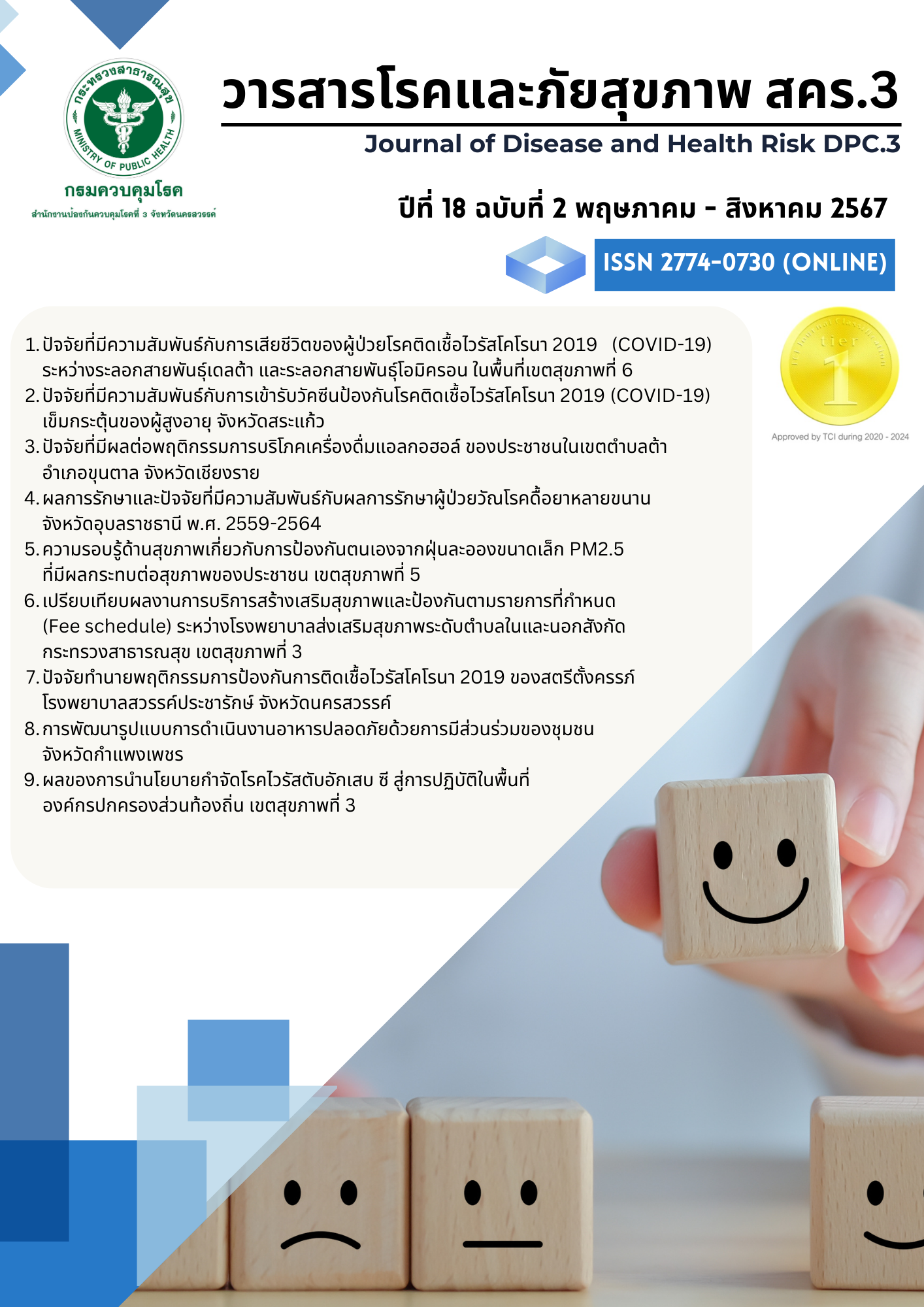ปัจจัยที่มีความสัมพันธ์กับการเข้ารับวัคซีนป้องกันโรคติดเชื้อไวรัสโคโรนา 2019 (COVID-19) เข็มกระตุ้น ของผู้สูงอายุ จังหวัดสระแก้ว
คำสำคัญ:
วัคซีนโควิด 19 เข็มกระตุ้น, การเข้ารับวัคซีน, ผู้สูงอายุ, จังหวัดสระแก้วบทคัดย่อ
วัคซีนโควิด 19 เข็มกระตุ้น เป็นปัจจัยสำคัญในการลดการแพร่ระบาด ลดอาการป่วยหนักและการเสียชีวิต โดยเฉพาะในกลุ่มผู้สูงอายุ แต่ยังพบการเข้ารับบริการน้อย การศึกษาครั้งนี้เป็นแบบ Community-based case–control study และประยุกต์ใช้ทฤษฎี PRECEDE Model เพื่อศึกษาปัจจัยที่มีอิทธิพลต่อการเข้ารับวัคซีนโควิด 19 เข็มกระตุ้น ของผู้สูงอายุ จังหวัดสระแก้ว โดยใช้ข้อมูลจากระบบฐานข้อมูลกลางของกระทรวงสาธารณสุข (MOPH IC) ในการค้นหากลุ่มตัวอย่าง และเก็บข้อมูลด้วยการสัมภาษณ์แบบตัวต่อตัวต่อกับกลุ่มตัวอย่าง ใช้สถิติเชิงพรรณนาอธิบายคุณลักษณะทั่วไป และใช้ Conditional logistic regression ทดสอบปัจจัยที่มีความสัมพันธ์ ผลการศึกษาพบว่า ในกลุ่มตัวอย่างทั้งหมด 324 คน แบ่งเป็นกลุ่มศึกษาและกลุ่มควบคุม กลุ่มละ 162 คน ส่วนใหญ่เป็นเพศหญิง ร้อยละ 53.7 อายุเฉลี่ย 67 ปี ปัจจัยที่มีความสัมพันธ์กับการเข้ารับวัคซีนโควิด 19 เข็มกระตุ้น อย่างมีนัยสำคัญทางสถิติ (p-value<0.05) ได้แก่ การรับรู้ว่าการติดเชื้อโควิด 19 มีความรุนแรงมาก ทำให้เกิดอาการเจ็บป่วยรุนแรงหรือเสียชีวิตได้ (OR adj = 7.951, 95%CI = 1.133-55.815) การรับรู้ผลข้างเคียงจากการฉีดวัคซีนเข็มกระตุ้น ในระดับน้อย (OR adj = 5.254, 95%CI = 1.381-19.983) ไม่เชื่อเลย (OR adj = 31.201, 95%CI = 5.321-182.969) และการไม่เคยมีประสบการณ์เกิดอาการข้างเคียงภายหลังฉีดวัคซีนเข็มก่อนหน้า (OR adj = 3.041, 95%CI = 1.141-8.108) นอกจากนี้ทั้ง 2 กลุ่ม ต้องการให้มีการให้บริการฉีดวัคซีนเชิงรุกในหมู่บ้านหรือชุมชน หรือสามารถเข้ารับบริการฉีดวัคซีนในสถานบริการใกล้บ้านได้ทุกวัน ดังนั้น จึงมีความจำเป็นอย่างยิ่งในการสร้างเสริมความรอบรู้ด้านสุขภาพให้กับผู้สูงอายุ ในประเด็นการรับรู้ต่างๆ โดยเฉพาะประเด็นความรุนแรงของการติดเชื้อ ผลข้างเคียงจากการฉีดวัคซีน และสื่อสารข้อมูลให้ผู้สูงอายุ รวมถึงญาติให้มีความเข้าใจเกี่ยวกับการเกิดอาการข้างเคียงภายหลังฉีดวัคซีนและการดูแล เพื่อให้ผู้สูงอายุมีความเชื่อมั่น และตัดสินใจเข้ารับบริการวัคซีนได้อย่างเหมาะสมต่อไป
เอกสารอ้างอิง
Baraniuk C. How long does covid-19 immunity last?. BMJ 2021; 373: n1605.
Silva-Cayetano A, Foster WS, Innocentin S, Belij-Rammerstorfer S, Spencer AJ, Burton OT, et al. A booster dose enhances immunogenicity of the COVID-19 vaccine candidate ChAdOx1nCoV-19 in aged mice. Med 2021; 2(3): 243-62.
Callaway E. COVID vaccine boosters: the most important questions. Nature 2021; 596: 178-80.
Mizrahi B, Lotan R, Kalkstein N, Peretz A, Perez G, Ben-Tov A, et al. Correlation of SARS-CoV-2-breakthrough infections to time-from-vaccine. Nat. Commun. 2021;12(1):6379.
Department of Disease Control. Ministry of Public Health. The situation of the coronavirus disease 2019. [cited 2022 February 21]. Available from: https://ddc.moph.go.th/covid19 dashboard/?dashboard=select-trend-line.
Ministry of Public Health. Booster dose vaccine. [cited 2022 February 21]. Available from: https://www.dmh.go.th/news-dmh/view. asp?id=31209.
Department of Disease Control. Ministry of Public Health. The situation of COVID-19 vaccination service. [cited 2022 February 11]. Available from: https://ddc.moph.go.th/vaccine-covid19/getFiles/10/ 1644807823246.pdf.
Ua-Kit N, Pensri L. Utilization of the PRECEDE MODEL in Health Promotion. Thai Red Cross Nursing Journal, Vol. 11 No.1 Janualy-June 2019, p. 38-48.
Rzymski P, Poniedzialek B, Fal A. Willingness to receive the booster COVID-19 vaccine dose in Poland. Vaccines (Basel) 2021;9(11):1286.
Malesza M, Wittmann E. Acceptance and intake of COVID-19 vaccines among older Germans. J Clin Med 2021;10(7):1388.
Wong MCS, Wong ELY, Huang J, Cheung AWL, Law K, Chong MKC, et al. Acceptance of the COVID-19 vaccine based on the health belief model: A population-based survey in Hong Kong. Vaccine 2021; 39(7): 1148-56.
de Andres AL, Garrido PC, Hernández-Barrera V, Del Pozo SV, de Miguel AG, Jiménez-García R. Influenza vaccination among the elderly Spanish population: trend from 1993 to 2003 and vaccination-related factors. Eur J Public Health 2007; 17(3): 272-7.
Alfageeh EI, Alshareef N, Angawi K, Alhazmi F, Chirwa GC. Acceptability of a COVID-19 vaccine among the Saudi Population. Vaccines (Basel) 2021; 9(3): 226.
Thaweelap S, Pobkeeree V. Factors associated with the acceptance of seasonal Influenza vaccination among the elderly in Phraphutthabat district, Saraburi province. The 12th Srinakharinwirot University Research Conference, 20 – 21 March 2019. Srinakharinwirot University 2019:740-51.
Shmueli L. Predicting intention to receive COVID-19 vaccine among the general population using the health belief model and the theory of planned behavior model. BMC Public Health 2021;21(1):804.
Contoli B, Possenti V, Minardi V, Binkin NJ, Ramigni M, Carrozzi G, et al. What is the willingness to receive vaccination against COVID-19 among the elderly in Italy? Data from the PASSI d' Argento Surveillance System. Front Public Health 2021;9: p736976.
Reiter PL, Pennell ML, Katz ML. Acceptability of a COVID-19 vaccine among adults in the United States: How many people would get vaccinated?. Vaccine 2020;38(42):6500-07.
Yadete T, Batra K, Netski DM, Antonio S, Patros MJ, Bester JC. Assessing acceptability of COVID-19 vaccine booster dose among adult Americans: A Cross-Sectional Study. Vaccines (Basel) 2021;9(12):1424.
Dambadarjaa D, Altankhuyag GE, Chandaga U, Khuyag SO, Batkhorol B, Khaidav N, et al. Factors associated with COVID-19 vaccine hesitancy in Mongolia: A Web-Based Cross Sectional Survey. Int J Environ Res Public Health. 2021, 18, 12903.
Wang J, Jing R, Lai X, Zhang H, Lyu Y, Knoll MD, et al. Acceptance of COVID-19 vaccination during the COVID-19 pandemic in China. Vaccines (Basel) 2020;8(3):482.
Lau JTF, Kim JH, Yang X, Tsui HY. Cross-sectional and longitudinal factors predicting influenza vaccination in Hong Kong Chinese elderly aged 65 and above. J Infect 2008; 56(6): 460-8.
Sa Kaeo Provincial Health Office. The situation of coronavirus disease 2019 and vaccine administration Sa Kaeo province. 2022.
Thanomsiang N. Sample size calculation for Case-Control Study. [cited 2022 February 21]. Available from: https://home.kku.ac.th/nikom/ss_ucc_mcc.pdf.
Chuenjai K, Punturaumporn B. Factors affecting the decision to vaccinate against CORONAVIRUS (COVID-19) of the population in Bangkok. [cited 2022 February 21]. Available from: https://mmm.ru.ac.th/MMM/IS/twin-9/6214154037.pdf.
Siriraj Academic Center of Geriatric Medicine. The Faculty of Medicine Siriraj Hospital. Caring for the elderly during the COVID-19 pandemic. [cited 2022 February 21]. Available from: https://www.si.mahidol. ac.th/sidoctor/ e-pl/admin/article_files/1417_1.pdf.
Department of Disease Control. Ministry of Public Health. Guidelines for COVID-19 vaccination in the 2021 outbreak situation in Thailand, 2nd revised edition. Samutprakarn: TS INTERPRINT; 2021.
Zarocostas J. How to fight an infodemic. Lancet [Internet]. 2020 [cited 2023 Oct 1]; 95(10225):676. Available from: https://www.thelancet. com/action/showPdf?pii=S0140-6736%2820% 2930461-X.
Roozenbeek J, Schneider CR, Dryhurst S, Kerr J, Freeman ALJ, Recchia G, et al. Susceptibility to misinformation about COVID-19 around the world. R Soc Open Sci. 2020; 7(10): 201199.
ดาวน์โหลด
เผยแพร่แล้ว
รูปแบบการอ้างอิง
ฉบับ
ประเภทบทความ
สัญญาอนุญาต
ลิขสิทธิ์ (c) 2024 วารสารโรคและภัยสุขภาพ สำนักงานป้องกันควบคุมโรคที่ 3 จังหวัดนครสวรรค์

อนุญาตภายใต้เงื่อนไข Creative Commons Attribution-NonCommercial-NoDerivatives 4.0 International License.
ประกาศเกี่ยวกับลิขสิทธิ์
|
บทความที่เผยแพร่ในวารสารโรคและภัยสุขภาพสำนักงานป้องกันควบคุมโรคที่ 3 จังหวัดนครสวรรค์ ถือว่าเป็นผลงานทางวิชาการหรือการวิจัย และวิเคราะห์ ตลอดจนเป็นความเห็นส่วนตัวของผู้เขียน ไม่ใช่ความเห็นของสำนักงานป้องกันควบคุมโรคที่ 3 จังหวัดนครสวรรค์ หรือกองบรรณาธิการแต่ประการใด ผู้เขียนต้องรับผิดชอบต่อบทความของตน |
นโยบายความเป็นส่วนตัว
|
ชื่อและที่อยู่ อีเมล์ ที่ระบุในวารสารโรคและภัยสุขภาพสำนักงานป้องกันควบคุมโรคที่ 3 จังหวัดนครสวรรค์ จะใช้เพื่อระบุตามวัตถุประสงค์ของวารสารเท่านั้น และจะไม่นำไปใช้สำหรับวัตถุประสงค์อื่น หรือต่อบุคคลอื่น |









